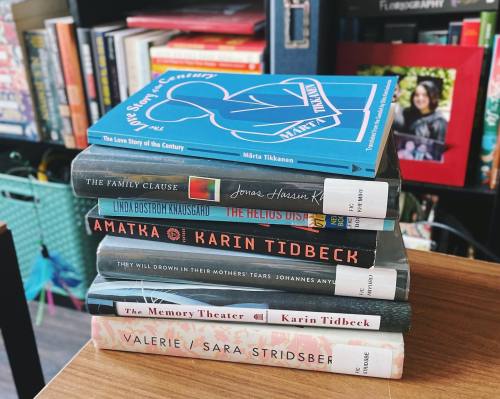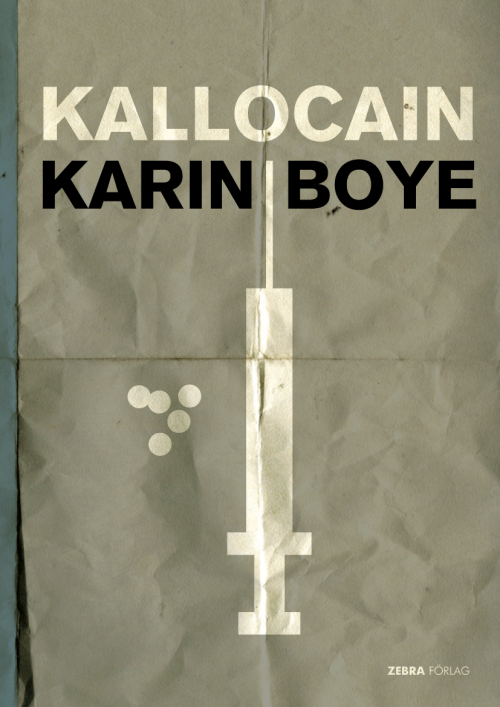#swedish literature
Because everyone loves someone, and anyone who loves someone has had those desperate nights where we lie awake trying to figure our how we can afford to carry on being human beings. Sometimes that makes us do things that seem ridiculous in hindsight, but which felt like the only way out at the time.
—Fredrik Backman, Anxious People.

Our bodies wailed and writhed, we itched with restlessness. We walked around like large irate animals in our parents’ houses, shouting for something that could still the strange swells, but wherever we looked all we saw were ready-made Female Models. We shut our mouths and closed our eyes, refusing to accept the inevitable. It was instinctive, an ember in the chest: anything could happen to us— just not that. So we fled to the greenhouse, turned away from the world, sough comfort in the earth and the flowers and the insects.
Kim, Momo, and Bella are at the hellish age of fourteen, longtime best friends and increasingly harassed and bullied at school. They still have a sanctuary though in the greenhouse at Bella’s. One day planting a strange seed that grows an unusual orchid like flower with sweet smelling nectar, they discover its power to physically turn their bodies into boys for a night. Embarking on a game that will not only test their friendship but, for one of them is much more serious.
Garnering prestigious awards and nominations, both banned and taught in schools along with glowingly recommended in LGBTQ+ lists, this was one of those dark YA fairytale-like books in a magical realism vein that I very much wondered what the author has to say about it. Fortunately, a Publishing Perspectives interview with Jessica Schiefauer from 2014 gives context. As the perspective of the English translator Saskia Vogel.
In the simplest terms in an earlier interview with TT News Agency in 2011 Schiefauer also puts it “This book doesn’t investigate what it is to be a boy,it investigates what it is not to want to be a girl.”And “I wish we didn’t have to be so strongly defined by our genders. I think that is the key for Kim, to just be Kim and not have to choose.”
Similarly, the Swedish title of Schiefauer’s novel is worth noting in that Pojkarnatranslates to ‘The Boys’. Several other translated editions echo this but there is sometimes variation with a different title such as Girls.Yet this went further when the film adaptation was screened internationally in 2015 using ‘Girls Lost’ in English. Though excerpts of the novel translated by Saskia Vogel first appeared in Words Without Border in 2014 using ‘The Boy’s’, the full novel’s English edition that followed years later in 2020 ties itself in name to the film. While further setting itself apart rejecting the largely subdued palates of many other editions by sporting a screaming pink neon cover by Anna Zylicz with illustration of hands holding and reaching for a flower, white text wrapping in a circle.
But if we shouldn’t judge a book by its cover, what is it about the material inside that has proved so intriguing? As mentioned in this case the novel has not just appeared in many languages but alongside a live-action adaptation. And the film’s interpretation is additionally interesting in that it led to the source material being analyzed more as a trans or queer narrative. (That categorization or not as the author says is something she’d wish take a back seat to discussions of gaze . To this broader point, I’d say the way people are perceived and therefore treated and conditioned, everything for that matter, can be immensely messed up.)

The director Alexandra-Therese Keining in only her second film and with a novice cast doesshift and give more space to certain issues of both femininity and masculinity, gender identity and performativity, along with sexuality. (Though the book is more explicit in some respects, enough it was as I mentioned banned in some schools in Sweden). This has a particular effect on the characterizations and relationships and the complexity.
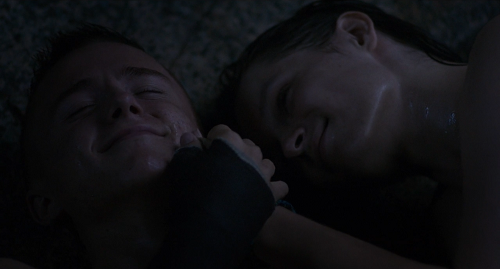
Tony a troubled punk on the exterior is an opportunity to show how (toxic) masculinity can also be restrictive and damaging. (Here too is where I’d like to point out that boys do still face messages about their bodies and value along with social expectations as well.) During Kim’s nighttime excursions they form a connection, that is not without sexual tension. Unfortunately the powerful bad boy mold can be flawed or an ill fit, and while overdue emotions and vulnerability surface, volatility reveals itself too.
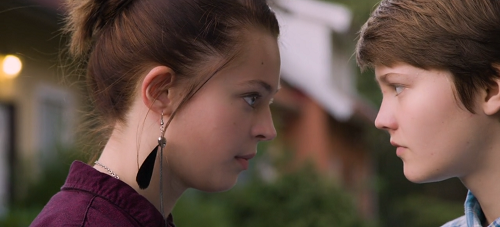
Momo and Kim as in the book share complex feelings of more than friends. As the story progresses Momo is acutely scared for and desperately tries to hold onto Kim. Kim confides more in Momo and a scene between her and Kim that markedly sticks out in the book is changed for the film.
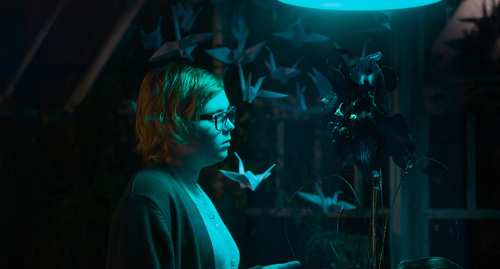
Bella who quickly tires of the nighttime outings is another example of “ways of contending with the term “gender”.” Misogyny is the topic that exists at the forefront of the novel. Bella is the target for Schiefauer’s recreation of an assault she witnessed in her youth. This is too a coming-of-age story and Bella as well reflects traditions of nature and the (divine) feminine. The metaphors with the greenhouse, and the special flower she chiefly looks after along with the friction that develops between her and Kim, is unsettling. As events also involving Momo near the end. No one despite their form can be free from violence or trauma. Though the book carries on to a different end point than the film and both are very open to interpretation.
Between its mediums I honestly prefer the film as Keining,who has become known for work with LGBTQ+ themes, takes up a center focus on certain subjects in contrast to the book. Yet, it can be argued as still continuing a binary and essentialist atmosphere. The book relies on a dichotomy that can undermine the nuance that does exist. I think it can be very challenging to craft a story like this with a lens thru identity, gender, and fluidity focused on the circumstances of young people growing up that won’t give some misgivings about what is trying to be said. Each individual navigating identity, sexuality, gender and growing older are experiences that remain regardless. Girls Lost seems to endure in the consciousness and it raises questions because of this. Yet for a story utilizing gender transformation to say something about identity and perception, it feels strangely somehow less world shattering going about it.
Girls Lost by Jessica Schiefauer is available in English translated by Saskia Vogel, in print and digital from Deep Vellum
View a trailer for the film adaptation directed by Alexandra-Therese Keining

“Silence can never be taken back.”
- The Ice Princess
Scandinavian literature is famous for its crime novels and bleak landscapes. But looking past Stieg Laarson, what Swedish books available in English translation should you read? Please don’t assume that all Swedish literature is cold crime investigation and psychological thrillers—you should know that childhood classic Pippi Longstocking came from Swedish author Astrid Lindgren, translated by Florence Lamborn.
I spent much of my March reading excellent Swedish literature, from emotional contemporaries to creative, thrilling speculative fiction, from Karin Tidbeck to Johannes Anyuru to Fredrik Bachman, to give you my most recent list of books in translation for Book Riot.
Post link

